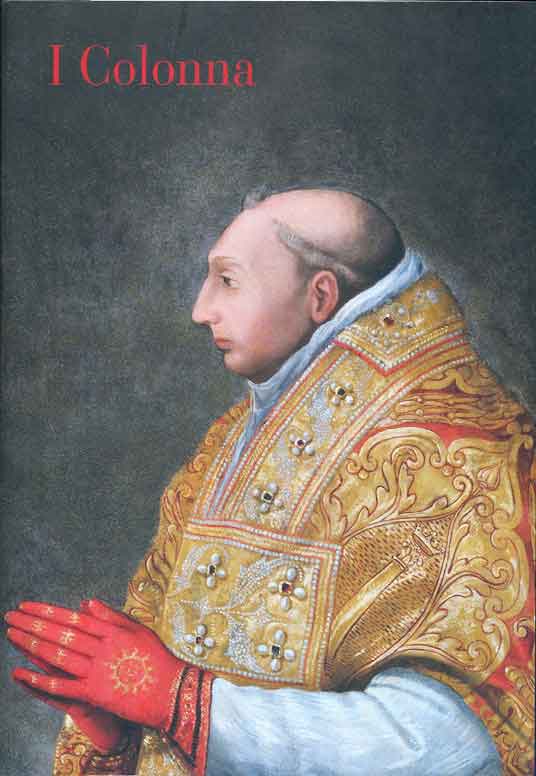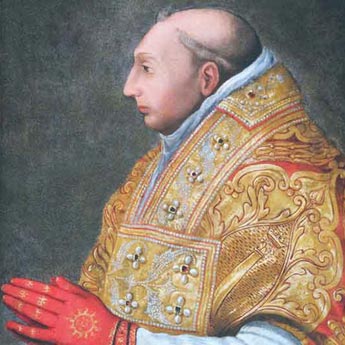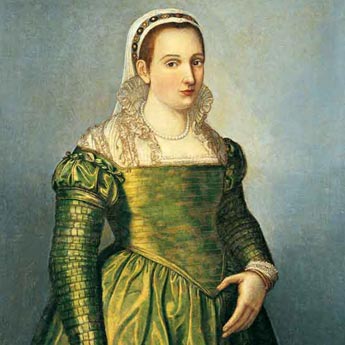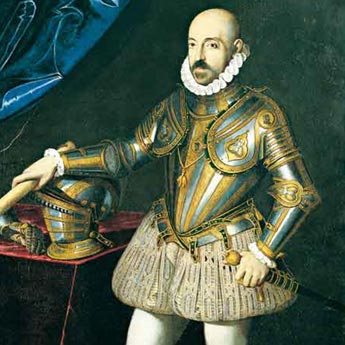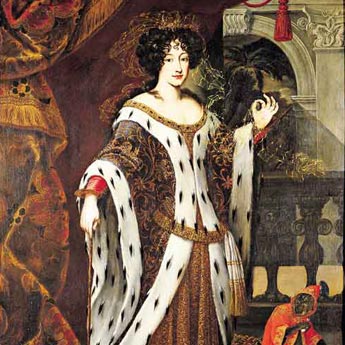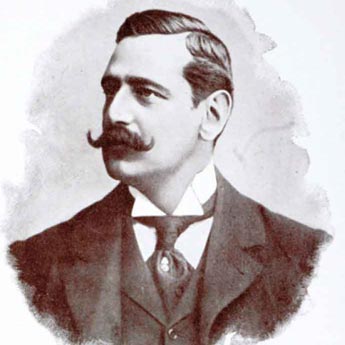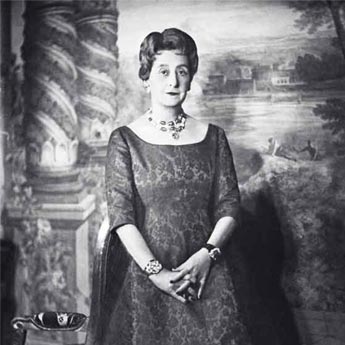The history of one of the oldest Roman families, from its origins in 12th century to the present day.
The Colonnas are an ancient Roman family whose history began nine hundred years ago. The very first documented member of the family was Pietro who lived between 1078 and 1108 in the countryside South of Rome, close to the town of Colonna from which the House derived its name.
Up to the present day there have been no less than 31 generations of the Colonna family, the main branch of which established itself from the beginning of 1200 on the slopes of the Quirinal Hill.
It was during that period that the Colonnas built their residences in the area of the present day Piazza SS. Apostoli, which within a short time developed into a veritable fortress. By the beginning of 1600 this massive structure had transformed itself into a grand Roman palace, which from then until the middle of the 1700’s was continually being restored and enlarged. From then until now Palazzo Colonna provides an impressive testimony to the history of the family from its first very adventurous centuries to the glamour and refinement of the later Baroque period. The stamp of so many famous artists who have honoured the Palace with their talents is still very much in evidence today. The Colonna Gallery is the prime example of this, evoking as it does a feeling of awe and excitement in many of today’s visitors.
Turning to important events of the family: the thirteenth and fourteenth centuries saw the first Colonna cardinals, Roman senators and military leaders who fought to assert and maintain the influence of the family during those turbulent times. In contrast there was also the mystical figure of Blessed Margherita (1255 – 1280), a contemporary and follower of St Francis. She was later beatified by Pope Pius IX in 1848.
During the 15th century the most important person by far in the family was Oddone Colonna. He became Pope Martin V at the end of the dark period of the Great Schism of the West which had split the papacy between Avignon and Rome. For almost a century Rome had been in a state of crisis with a power vacuum provoking violent armed clashes between rival families, the foremost of which were between the Colonna and the Orsini. Such clashes involved Pope Boniface VIII of the Caetani family who was a bitter enemy of the Colonnas. This was when Sciarra Colonna was involved in a famous scuffle with the Pope in his home town of Anagni in which he struck him in public and which became known as the ‘Schiaffo di Anagni’ (The Anagni Slap). However this was not an isolated incident as it also involved various other pontifical vicars who succeeded one another from the time of the Avignonese popes and also those from the period of Cola di Rienzo, all of whom allied themselves to the Orsini and hence were enemies of the Colonnas. The two families ruled over not only their respective quarters in Rome but also two large rural areas around the city; the North dominated by the Orsini and the South by the Colonnas. Both areas were garrisoned by the respective families and they controlled the major roads into Rome; the Appia, Prenestina e Casilina by the Colonna and the Flaminia, Salaria and Cassia by the Orsini.
Pope Martin V again made Rome the Apostolic Seat initiating a programme of sorely needed law and order together with some serious reconstruction in this badly run down city. The Roman Renaissance had in Martin V a truly illustrious representative. He commissioned the restoration of the four principal Roman Basilicas giving them the same degree of attention that he gave to the reorganization of the various pontifical departments. He nominated as his residence Palazzo Colonna which therefore then become the Apostolic Seat for eleven years.
In the second half of the 1400’s the family was faced with another Pope allied to the Orsini, Pope Sixtus IV of the della Rovere family. Rome was again plunged into a climate of bitter clashes between the various factions which continued unabated right up to and into the pontificate of the Borgia Pope, Alexander VI. This turbulent period was finally brought to an end through the patience and prolonged mediation of another Pope of the della Rovere family, Julius II, when he brokered a peace treaty between the Colonna and the Orsini. This accord, known as the ‘Pax Romana’(1511), finally concluded the bloody conflict between the two families which had lasted for more than two centuries. The heads of the two houses, Fabrizio I Colonna and Giulio Orsini, in the Pope’s presence and with representatives from the maximum number of the other noble families, solemnly swore to cease all hostilities. This binding pledge was signed and carried out in front of the altar and also included an agreement to forgive each other for all past offences.
The peace between the two families was cemented by the marriage between Marcantonio II Colonna and Felice Orsini. The parents of Marcantonio were Ascanio and Giovanna d’Aragona, the niece of Emperor Charles V. Such an illustrious connection revealed its usefulness during ‘The Sack of Rome’ when Imperial troops looted and set fire to whole areas of the city and put thousands to the sword. However during this prolonged pillage, Palazzo Colonna was not touched and in fact was able to offer asylum and protection to three thousand of its citizens including many Cardinals and the famous Isabella d’Este, Duchess of Mantua.
Ascanio’s sister was the poetess Vittoria Colonna. She was an intimate friend and muse of Michaelangelo and they had many meetings together at the Palace. They also exchanged letters and sonnets over a long period and it is clear she had a great influence on his work. So close was their friendship that Michaelangelo painted her in his famous Universal Judgment behind the altar of the Sistine Chapel. You can see her profile in the portrait of the woman above and to the right of Simone of Cirene, the one carrying the cross, close to the self-portrait of the painter.
The most prominent member of the family during that period was Marcantonio II, who crowned his adventurous life with the leadership of the Papal fleet at the famous battle of Lepanto against the Turkish fleet at which he triumphed. The subsequent prestige that this brought was rewarded by his nomination as Viceroy of Sicily by King Philip II of Spain.
One of the daughters of Marcantonio II and Felice Orsini was Costanza who befriended Caravaggio and became his protector from the very beginning and all through his rumbustious meteoric artistic career. During his time in Rome, Caravaggio was a frequent guest of palazzo Colonna and here he first sought refuge after his famous duel with Ranuccio Tomassoni which resulted in his opponent’s death. Costanza then organised his escape to Naples via a short stay at their Palace in Paliano just South of Rome.
During the course of the 1600’s the Colonnas consolidated their considerable influence in Rome and in the courts of both Spain and France. Filippo I, Cardinal Girolamo I and Lorenzo Onofrio, the husband of Maria Mancini Mazzarino, all contributed to the extension of important family connections through friendship, as opposed to what had previously been achieved through recourse to arms. This century also saw the restoration of the family’s palaces; a large expansion of their various collections; a greater use of the art of diplomacy and their important patronage of many artists.
There was also a renewed emphasis on ‘arranged marriages’, a shrewd policy that linked the family to a series of other illustrious houses. At the same time the Colonnas consolidated their faithful and loyal ties to the Holy See, now no longer hindered by those frequent violent forays and their Imperial bias of the past centuries.
This century also saw the complete restoration and transformation of Palazzo Colonna into a sumptuous Roman residence along with the construction of its magnificent Galleria Colonna.
In the 1700’s the most influential family members included: Fabrizio II, husband of Caterina Zeffirina Salviati who gave birth to no less than sixteen children. Amongst them were two future cardinals: Marcantonio and Pietro and their first born, Lorenzo II, who married Marianna d’Este. They together with their son Filippo III lived through another period of great change in the history of the family. Filippo once more took the necessary steps relevant at this time to maintain the influence and power of the family. He married Caterina Savoia Carignano and strengthened ties with both France and Spain. He was a faithful and loyal advisor to both Pope Pius VI and Pius VII, supporting them during the difficult period of the Napoleonic occupation of both the Pontifical State and Rome. He helped Pius VI militarily and gifted buildings to Pius VII for use as barracks. The ones in Rome were in Piazza della Pilotta next to Palazzo Colonna and they became the Gregorian University in 1930. Another was the castle at Paliano which later became a prison.
During the 1800’s we meet three brothers, sons of Giovanni Andrea Colonna and Isabella Alvarez de Toledo, who well illustrate the family’s vitality. The first born, Marcantonio, entered the service of the Holy See during the long pontificate of Pius IX in another difficult period which led up to the famous battle of Porta Pia in 1870. His brother, Fabrizio, was a cavalry general and Senator of the Kingdom of Italy and entered Rome with a troop of Savoy cavalry. Full of Catholic fervour, he represented the more liberal spirit of the family. The youngest brother, Prospero, became an administrator, entering local politics and was mayor of Rome for three terms of office. Together they started a new direction for the family, less formal and more in tune with the new social order of those changing times.
Among the many illustrious family members in the 20th century, the sons of Fabrizio and Olympia Doria Pamphilj merit special mention. One was Ascanio who was the Italian Ambassador in Washington during the Second World War and to whom fell the unenviable task of giving the despicable declaration of war by our country to President Roosevelt. On the same day he resigned his post, not wishing to represent the Kingdom of Italy and its reckless government. The other was Marcantonio who married Isabelle Sursock of Lebanese origin in 1908.
Donna Isabelle, as she then became known, occupied a prime position amongst the élite of Roman Society throughout her long life up to the 1980’s. She was a lady of great intelligence and power who defended and jealously guarded the artistic collection of the family through the darkest periods of both of the two World Wars. She and her husband were intensely loyal to the Holy See, so much so that she was given the rare honor of Vatican citizenship. She never abandoned ‘her’ Palace that she so profoundly loved and where she wove her diplomatic skills at the highest level, receiving Heads of State and Royalty from half the world. Narrowly escaping arrest by the Neofascists, she continued to always keep uppermost the interests and image of the family to which she was so proud to belong.
Through her vision and dedication, Palazzo Colonna was conserved and restored to its former glory and the family owes a profound debt of recognition to this great lady. She also instilled in both her children and grandchildren their great responsibility for its preservation. Her personal stamp on the Palace is seen especially in two splendid apartments dedicated to her: the Princess Isabelle Apartment and the Gallery Apartment. These are open to the public on Saturday mornings or privately on request every day of the Year.
An adventure lasting over 900 years, describing its decisive moments and key figures.
In the background is the fascinating history of Rome from the Middle Ages to the Renaissance, and then from Baroque extravagance to modern times. The Eternal City, heart of Christendom, home of the Pope, capital of the Church State, of the Kingdom then the Republic of Italy.
The reader is taken back through many episodes of Rome’s history over the last nine centuries, some well known others less so. These are the frame work for the varius events involving distinguished members of the Colonna family.
A very readable historical compendium, an easy reference, with no academic aspirations but carefully researched, as confirmed by the rich bibliography.
A very interesting new book on the history of the Colonna family from the very beginning up to our days (euro 50) available :- at our book shop in via della Pilotta, 17 Rome every Saturday morning from 9 a.m. to 1,15 p.m. – at our Office in Piazza SS. Apostoli,66 Rome from Monday to Friday 9 a.m. – 6 p.m. – by mail on request tel +39 06 6784350 or info@galleriacolonna.it.
- Oddone Colonna 1368–Pope from 1417 to 1431
- Vittoria Colonna (1492 – 1547 ) Poetess and friend to Michelangelo
- Marcantonio II Colonna ( 1535-1584) Commander of the Popal Fleet at the Lepanto Battle
- Maria Mancini Colonna ( 1639-1716 ) niece of Cardinal Mazzarino
- Prospero Colonna ( 1858-1937 ) Mayor of Rome ( 1899-1904; 1914-1919 )
- Princess Isabelle Colonna (1889–1984)
INDEX
Pag. 8
Preface
Prospero Colonna
Pag. 15
Chapter 1 – The 12th Century
Family Origins
Pietro I, known as “della Colonna”
Cardinal Giovanni I Colonna
Prospero Colonna
Pag. 23
Chapter 2 – The 13th Century
Cardinal Giovanni II Colonna
The Blessed Margherita Colonna
Pope Boniface VIII Caetani and the Colonna
Natalia Gozzano
Pag. 43
Chapter 3 – The 14th Century
Pope Boniface VIII Caetani and the Colonna
Sciarra Colonna
Giacomo and Stefano Colonna
Petrarch and the Colonna
The Avignon Schism
Stefano Colonna and Cola di Rienzo
Natalia Gozzano
Pag. 71
Chapter 4 – The 15th Century
Pope Martin V Colonna
Cardinal Giovanni Bessarione
Pope Sixtus IV della Rovere and the Colonna
Pope Julius II della Rovere and the Colonna
Natalia Gozzano
Pag. 91
Chapter 5 – The 16th Century
Marcantonio I and Lucrezia Gara della Rovere
The Pax Romana, Ascanio Colonna and Giovanna d’Aragona
The Sack of Rome
Vittoria Colonna and Michelangelo
Marcantonio II Colonna and Felice Orsini
Pope Paul IV Carafa and the Colonna (Peace Treaty of Cave)
Pope Pius V Ghislieri and the Battle of Lepanto
Costanza Colonna and Caravaggio
Fabrizio Colonna and Anna Borromeo
Pope Sixtus V Peretti and the Colonna
Marcantonio III Colonna (first Prince Assistant to the Papal Throne) and Felice
Orsina Damasceni Peretti
Prospero Colonna, Natalia Gozzano
Pag. 141
Chapter 6 – The 17th Century
Filippo I Colonna and Lucrezia Tomacelli
Cardinal Girolamo I Colonna
Lorenzo Onofrio Colonna and Maria Mancini
Filippo II Colonna and Olimpia Pamphilj
Prospero Colonna, Natalia Gozzano
Pag. 179
Chapter 7 – The 18th Century
Fabrizio Colonna and Caterina Zefferina Salviati
Pope Benedict XIV Lambertini
Cardinals Girolamo II, Marcantonio and Pietro Colonna Pamphilj
Peace Treaty of Tolentino: Pope Pius VI Braschi and Napoleon
Filippo III Colonna and Caterina Savoia Carignano
Prospero Colonna
Pag. 215
Chapter 8 – The 19th Century
Marcantonio, Fabrizio and Prospero Colonna
Three brothers in the life of 19th-century Rome
Prospero Colonna
Pag. 239
Chapter 9 – The 20th Century
Marcantonio Colonna and Isabelle Sursock
Aspreno Colonna and Maria Milagros del Drago
Sveva Colonna Pio Falcò
Prospero Colonna
Pag. 265
Chapter 10 – The 21st Century
The present days
Prospero Colonna
Pag. 273
Appendix
Colonna Family Tree
Pag. 301
Bibliography










